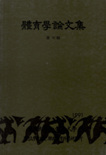- 영문명
- The Effect on Swimming Training on Body Composition, Strength and Heart-Rate
- 발행기관
- 경희대학교 스포츠과학연구원
- 저자명
- 高東信(Ko Dong Shin) 兪承熙(Yoo Seung Hee)
- 간행물 정보
- 『체육학논문집』제19집, 33~47쪽, 전체 15쪽
- 주제분류
- 예술체육 > 체육
- 파일형태
- 발행일자
- 1991.12.01

국문 초록
영문 초록
The objective of this study is to ascertain the effects that swimming has on physical structure, physical strength, and athletic performance capacity.
The traning group was composed of ten student members of the "K" University amateur swim team while the comparative group was composed of ten ordinary students. The training roup, with the exception of Sundays, trained for about an hour daily for a period of six weeks.
Inorder to ascertain physical structure, the thickness of subcutaneous fat, percentage of bodyfat, and weight of body fat were measured. Finally, to ascertain the change in athletic performance capacity, heart rate, athletic endurance, and time till appearance of PWC170 were measured using a cycle ergometer.
The first measurements were taken before the experiment. The second measurements were taken after three weeks. The last measurements were taken after six weeks. The following resurts were obtained after analyzing the measurement data:
1) The swimming group, as compared to the control group, decreased the thickness of subcetaneous fat, percentage of bodyfat.
2) Excecising abiligty time of the control group and the training group average (8.07, 8.22 min) at first, The control group averaged (3.97) rose and decreased (1.61%), but the swimming group’s average was(1.22%) and continue rose (3.28%) after three, six weeks.
3) PWC 170 of the control group and the swimming group averaged (6.32, 6.30 min) at first. The control group averaged (1.90%) rose and decreased (-0.79), but the training group’s average was(1.99%) and continue rose (5.11%) after three, six weeks.
4) General heart-beat of the control group and the swimming group averaged (72.20, 71.80 beat/min) at first.
The control group averaged (0.55%) rose and decreased (-1.39) and continue decreased (-4.57) after three, six weeks.
5) The best heart-beat of the control group and the swimming group averaged (192.20, 191.60 beat/min) at first.
The control group averaged (0.41%) rose and decreased (-0.52), but the swimming group’s average was (-3.40) and continue decreased (-1.77) after three, six weeks.
6) The swimming group, as comparsed to the comparative group, showed a striking reduction in heart rate both during activity and at rest.
Synthesizing the above resurt it is found that not only was the scope of the swimming group’s improvement of physical strength comparatively large, but also that they showed reduction in body fat. Further more, their normal and maximum heartbeat, either active or at rest was reduced.
Finally, they both increased their athletic endurance and time till appearance of PWC170.
The traning group was composed of ten student members of the "K" University amateur swim team while the comparative group was composed of ten ordinary students. The training roup, with the exception of Sundays, trained for about an hour daily for a period of six weeks.
Inorder to ascertain physical structure, the thickness of subcutaneous fat, percentage of bodyfat, and weight of body fat were measured. Finally, to ascertain the change in athletic performance capacity, heart rate, athletic endurance, and time till appearance of PWC170 were measured using a cycle ergometer.
The first measurements were taken before the experiment. The second measurements were taken after three weeks. The last measurements were taken after six weeks. The following resurts were obtained after analyzing the measurement data:
1) The swimming group, as compared to the control group, decreased the thickness of subcetaneous fat, percentage of bodyfat.
2) Excecising abiligty time of the control group and the training group average (8.07, 8.22 min) at first, The control group averaged (3.97) rose and decreased (1.61%), but the swimming group’s average was(1.22%) and continue rose (3.28%) after three, six weeks.
3) PWC 170 of the control group and the swimming group averaged (6.32, 6.30 min) at first. The control group averaged (1.90%) rose and decreased (-0.79), but the training group’s average was(1.99%) and continue rose (5.11%) after three, six weeks.
4) General heart-beat of the control group and the swimming group averaged (72.20, 71.80 beat/min) at first.
The control group averaged (0.55%) rose and decreased (-1.39) and continue decreased (-4.57) after three, six weeks.
5) The best heart-beat of the control group and the swimming group averaged (192.20, 191.60 beat/min) at first.
The control group averaged (0.41%) rose and decreased (-0.52), but the swimming group’s average was (-3.40) and continue decreased (-1.77) after three, six weeks.
6) The swimming group, as comparsed to the comparative group, showed a striking reduction in heart rate both during activity and at rest.
Synthesizing the above resurt it is found that not only was the scope of the swimming group’s improvement of physical strength comparatively large, but also that they showed reduction in body fat. Further more, their normal and maximum heartbeat, either active or at rest was reduced.
Finally, they both increased their athletic endurance and time till appearance of PWC170.
목차
ABSTRACT
Ⅰ. 緖論
Ⅱ. 硏究對象 및 方法
Ⅲ. 硏究成績
Ⅳ. 考察
Ⅴ. 結論
參考文獻
Ⅰ. 緖論
Ⅱ. 硏究對象 및 方法
Ⅲ. 硏究成績
Ⅳ. 考察
Ⅴ. 結論
參考文獻
키워드
해당간행물 수록 논문
참고문헌
최근 이용한 논문
교보eBook 첫 방문을 환영 합니다!

신규가입 혜택 지급이 완료 되었습니다.
바로 사용 가능한 교보e캐시 1,000원 (유효기간 7일)
지금 바로 교보eBook의 다양한 콘텐츠를 이용해 보세요!


